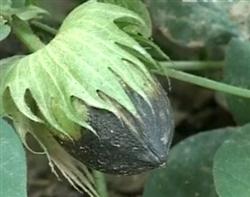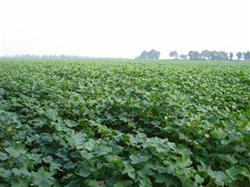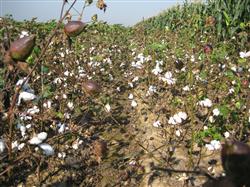How to control cotton rotten bolls (peaches)?

How to prevent and cure cotton rotten boll (peach)? Please introduce the method of cotton boll rot, which mostly occurs from mid-late August to early September. During this period, if it is wet and overcast, the cotton field is hidden, and the ventilation and light transmission is poor, many kinds of bacteria will breed rapidly. The common cotton boll rot diseases are anthracnose, black fruit disease, blight, red rot, powdery mildew, soft rot and so on. The light ones can not open bolls normally, the floc decreases, the heavy bolls can not crack, and the shell is rotten without harvest, which seriously affects the high yield and high quality of cotton. The prevention and control measures are as follows: first, when there are too many Rain Water in the middle and later stage of waterproof cotton, attention should be paid to timely clearing ditches and drainage to reduce soil moisture in cotton fields, so as to prevent premature root senescence and reduce boll rot. Second, pruning in the later stage of fine pruning is an effective measure to reduce nutrient consumption, improve ventilation and light transmission, and prevent boll rot. In late August, the top of the upper fruit branch and the ineffective buds in the middle of the cotton plant were removed to reduce nutrient consumption. The old branches with no function in the lower part and all empty branches are also removed to reduce the concealment of cotton fields, increase ventilation and light, and promote the smooth opening of mature bolls. 3. Chemical control for cotton fields that have developed boll rot disease, Bordeaux solution of 1purl 100, or 400 times of mancozeb, or 600 times of mancozeb, can be sprayed 2 times 3 times, and the effect of preventing boll rot is obvious. Fourth, early picking rotten bolls in case of overcast and rain, when rotten bolls are found, cotton bolls over 40 days old and lower cotton bolls with black spots can be removed. After soaking with 0.5%-0.1% ethephon, drying can become normal boll opening, which has no effect on boll weight and quality. Fifth, push the plant and ridge in the tightly sealed cotton field, you can take advantage of the sunny day to push the cotton plant by hand and step on the root of the cotton plant to the outside, so as to make the cotton plant tilt out and divide a ventilation duct. After 5 days and 7 days, the two rows of cotton plants with ridges were pushed aside and stepped on the side, which could reduce the humidity between the rows and reduce the rotten bolls. Sixth, ploughing and dispersing dampness in combination with pushing plants and ridges at the same time, ploughing can also play a role in loosening soil and dispersing dampness and reducing rotten bolls. 7. Phosphorus and potassium should be added to the growing cotton fields as early as possible, and about 20 kg of calcium phosphate and 10 kg of potassium sulfate should be applied per mu. From mid-August to early September, 150 kilograms of potassium dihydrogen phosphate per mu was sprayed with 40 kilograms of water for 3 times to promote cotton bolls to crack and open bolls as soon as possible. 8. Spraying ethephon in cotton field can improve the disease resistance of green boll, promote the early fall of old leaves, prevent field depression, promote cotton boll early cracking and early boll opening. The method is about 20 days before Frosts Descent, 40% ethephon 150 million 200 grams, 50 kilograms of water, can be evenly sprayed. Click to get more cotton planting technology click to get more food crop planting technology
- Prev

How to fertilize cotton?
How to fertilize cotton? Please introduce the method of planting cotton can refer to the following methods of fertilization: 1, the chemical fertilizer used in the base fertilizer can be sprinkled on the surface in front of the cultivated land, and turned into the ground together with farm manure. In this way, it can be applied deeply and evenly, with less nutrient loss, and can be absorbed and utilized by cotton roots distributed everywhere. 2 、...
- Next

How to prevent premature senescence in the later stage of cotton?
How to prevent premature senescence in the later stage of cotton? Please introduce the method the internal reason for the early senescence of cotton is that after cotton growth entered August, there was a fierce competition for nutrients among roots, stems, leaves and bolls, resulting in an imbalance between nutrient supply and demand; the external cause was the lack of water and fertilizer in the later stage of cotton fields. such as phosphorus deficiency or deficiency.
Related
- The first cup of black tea in spring, the flavor and history of tea gardens in Kenya, Africa
- The computer can not only choose potatoes, but also grow tea rice. AI will grow winter oolong tea champion.
- It is not only the inflated tea bitten by insects, but also engraved with the four seasons tea in Beipu.
- The Oriental Beauty Tea Festival in Zhuxian County takes the stage at the weekend to experience the plus-size feast of oil tea.
- & quot; Oriental Beauty Tea & Exploration of Emei in Hsinchu, the hometown of quot;
- The new variety of strawberry "Tainong 1" dessert is the first choice with mellow aroma. Crimson gorgeous
- History of Tea in Taiwan: from Wild Inner Mountain to Export Tea Garden
- Two types of Taiwan Oriental Beauty Black Tea won the British three-Star Award for Childhood Tea Xiang Zhang Jiaqi changed from pilot to champion tea maker.
- Banana species and varieties: the planting history of Taiwan Xianren banana and dwarf banana is long, is banana disease resistant?
- Coffee planting Technology: Qianjie Coffee from Seedling to harvesting

